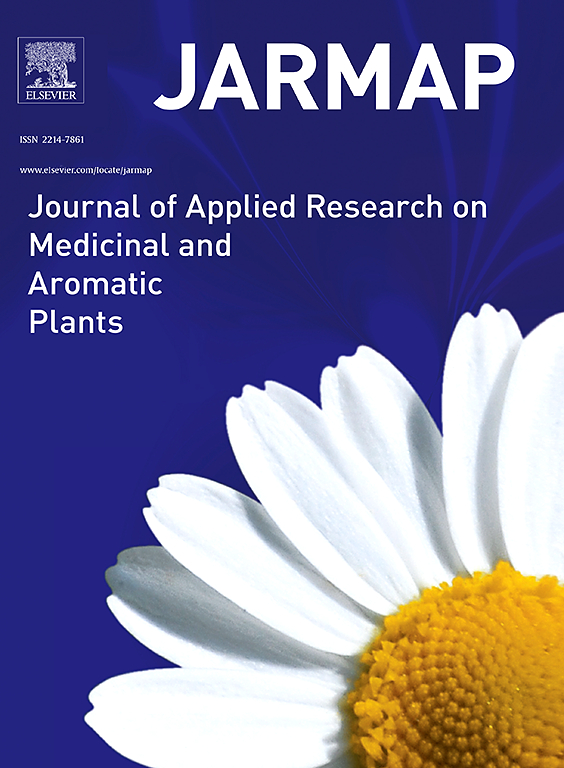Optimization of ultrasound phenolic extraction from Erica multiflora leaves using response surface methodology and artificial neural networks
IF 3.6
2区 农林科学
Q1 PLANT SCIENCES
Journal of Applied Research on Medicinal and Aromatic Plants
Pub Date : 2025-01-22
DOI:10.1016/j.jarmap.2025.100627
引用次数: 0
Abstract
This study aimed to develop and optimize an efficient ultrasound-assisted extraction method for phenolic compounds from Erica multiflora leaves, with the primary objectives of preserving extract quality, minimizing solvent usage, and standardizing extraction conditions. A total of 15 extractions were performed, varying solvent concentration, extraction time, and ultrasonic amplitude, using a Box-Behnken design. The effects of the extraction parameters on phenolic yield were modeled using response surface methodology (RSM) and artificial neural networks (ANN). Both models demonstrated strong predictive capabilities for all measured responses. Among the extraction parameters, amplitude and time were identified as key factors influencing phenolic yield. The optimized conditions 50.79 % solvent concentration, 60 seconds extraction time, and 86.38 % ultrasonic amplitude resulted in a TPC of 106.42 ± 3.79 mg gallic acid equivalents (GAE) per gram of dry weight (DW), a TFC of 14.37 ± 0.51 mg quercetin equivalents (QE) per gram DW, and a DPPH antioxidant capacity of 3.11 ± 0.85 mg ascorbic acid equivalents (AE) per gram DW. The experimental results closely matched the model predictions, validating the optimization process. The methanolic extracts of Erica multiflora demonstrated significant potential for use in pharmaceuticals, nutraceuticals, and functional foods.
基于响应面法和人工神经网络的超声多酚提取工艺优化
以保证提取物质量、减少溶剂用量、规范提取条件为主要目标,建立并优化超声辅助提取多花莲叶中酚类化合物的方法。采用Box-Behnken设计,在不同的溶剂浓度、提取时间和超声振幅下,共进行了15次提取。采用响应面法(RSM)和人工神经网络(ANN)对提取工艺参数对苯酚得率的影响进行了建模。两种模型对所有测量的响应都显示出很强的预测能力。在提取参数中,振幅和时间是影响苯酚得率的关键因素。 % 50.79溶剂浓度的优化条件,60 秒萃取时间,和86.38 %超声波振幅导致TPC 106.42 ±3.79 mg没食子酸当量(GAE)每克干重(DW),交通14.37 ±0.51 毫克每克DW槲皮素等价物(QE),和DPPH 抗氧化能力3.11±0.85 毫克每克DW抗坏血酸等价物(AE)。实验结果与模型预测结果吻合较好,验证了优化过程。多花莲的甲醇提取物在制药、营养保健品和功能食品中具有重要的应用潜力。
本文章由计算机程序翻译,如有差异,请以英文原文为准。
求助全文
约1分钟内获得全文
求助全文
来源期刊

Journal of Applied Research on Medicinal and Aromatic Plants
Pharmacology, Toxicology and Pharmaceutics-Drug Discovery
CiteScore
6.40
自引率
7.70%
发文量
80
审稿时长
41 days
期刊介绍:
JARMAP is a peer reviewed and multidisciplinary communication platform, covering all aspects of the raw material supply chain of medicinal and aromatic plants. JARMAP aims to improve production of tailor made commodities by addressing the various requirements of manufacturers of herbal medicines, herbal teas, seasoning herbs, food and feed supplements and cosmetics. JARMAP covers research on genetic resources, breeding, wild-collection, domestication, propagation, cultivation, phytopathology and plant protection, mechanization, conservation, processing, quality assurance, analytics and economics. JARMAP publishes reviews, original research articles and short communications related to research.
 求助内容:
求助内容: 应助结果提醒方式:
应助结果提醒方式:


